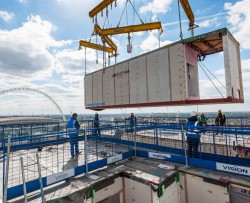Homes England’s Affordable Homes Programme could prove a
step-change in the mainstream adoption of modular and offsite construction.
Jahanara Hussain and Sarah Hale of UK law firm TLT examine what needs to happen
to de-risk modular and secure its future
In 2020, Homes England announced the new five-year
Affordable Homes Programme (AHP) as part of the government’s plans to tackle
the housing crisis and provide would-be homeowners with a step on to the
housing ladder.
As part of the AHP, Homes England will be making over £7.3bn
available to developers from April 2021. Modern Methods of Construction (MMC)
will be integral to the programme and achieving the target of 130,000
affordable homes (outside of London) by 2026 – so much so that the government
expects strategic partners to adopt at least 25% MMC in future schemes.
Evidently then, modular and MMC are set to play a greater role in the housing
development sector and stakeholders must be prepared.
Modular in the mainstream
Generally, modular housing involves a process whereby
building elements are constructed in an offsite factory before being
transported to a building site for assembly. Presently, modular has failed to
break into the mainstream in recent years: negative comparisons have been made
to post-WWII prefab housing and some high-profile modular firms have reported
significant losses from start-up costs. However, the latest AHP could change
the direction of travel for the modular industry and lead to wider acceptance
of MMC across the development sector.
Indeed, Mark Farmer – the government’s own champion for MMC
– co-authored a recent report advocating for the government to embark on a
programme to build 75,000 modular homes a year. According to his report, Farmer
stated that such a programme would create 50,000 new jobs, add 0.75% to GDP and
reduce carbon emissions in new homes by up to 40%, bringing potentially
significant benefits for the planet as well as the UK economy.
Following the government’s declaration of a 2050 net zero
emissions goal and the launch of schemes such as the Green Homes Grant, modular
housing and offsite construction could become key to lowering the carbon
footprint of the housing development sector in the UK. For example, efficient
manufacturing and streamlined design reduce waste going to landfill, while
energy use can be monitored and adapted much more efficiently in a factory
setting as opposed to a conventional construction site. The reduced
transportation of materials can also reduce congestion and air pollution in the
immediate area.
Furthermore, modular brings opportunities to integrate homes
into grid connections more easily, delivering major advantages for
sustainability. For instance, modular homes can be designed to have built-in
energy efficiency, with many being powered through solar panels, reducing the
need for energy from the grid. Better insulation can also lead to better
efficiency and lower energy bills, reducing heat loss and energy wastage.
Securing the future of modular
Although the adoption of MMC in the AHP and growing demand
for modular is great news for those working in the sector, there remain a
number of obstacles, particularly for developers. De-risking modular is chief
among these concerns – especially in construction, storage, inspection and
quality control, as well as installation and payments. Without addressing these
risks, the parties may find that their contract does not protect them in the
way they had hoped.
Unlike more traditional methods of construction, modular
requires developers to pay upwards of 60% of costs before the end product
reaches the site. Developers should therefore consider regular inspections of
factories to be essential, making sure that units are up to specification
requirements before signing off and releasing any payments.
Another risk for developers is a manufacturer becoming
insolvent. If this were to happen, developers might be left without the supply
needed to meet pre-set goals and would need to then conduct a procurement
process to find products elsewhere.
However, developers can mitigate the risk presented by a
manufacturer insolvency and increase resiliency by conducting investigations
into the finances, reputation and stability of the other party and checking
that contracts with manufacturers provide adequate protection against the
impact of insolvency.
Another measure that developers can take is the review of
contractual terms on a regular basis to see whether they can be further
modified or enhanced to hedge against exposure.
To de-risk modular, developers should also consider their
heads of terms ahead of any transactions. For example, including a performance
bond to provide security for the upfront payments made to the modular supplier,
as well as rights to test the quality of the works, which can be done at
various stages of the offsite construction process.
Futureproofing modular will be essential to assuaging any
concerns as to the longevity of projects. Designing units that are easily
adaptable to changing needs and requirements, such as renewable energy
infrastructure and technology, are some considerations that should be made. The
modular provider should also provide details of maintenance through the
lifecycle of the home, and it may also be pertinent for the buyers to establish
a maintenance programme with the supplier for its estimated lifecycle.
A good foundation
The measures contained in the new AHP should provide a
significant incentive for the market to develop and reach a level of maturity
to allow for buy-in from developers. Modular is hailed as a panacea for
tackling the housing crisis but the government, manufacturers and developers
alike must all develop a more comprehensive understanding of how MMC fits into the
sector.
If modular is to be the future of construction and housebuilding in the UK, de-risking is core to its wider take-up. Developers should remain cognisant of the ways in which this can be achieved as they begin to use more MMC and make sure they stay up to date with regulations and sector innovation. By doing so, the sector can take advantage of the opportunities presented, meet the needs of the housing crisis and create sustainable homes that will last into the future.
Original Source: PBC Today









